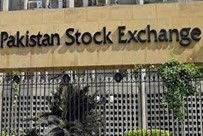 Index slipped 5,815 pts in FY22
Index slipped 5,815 pts in FY22
Pak stocks suffered a rout during FY22 amid deep uncertainty to close at 41,541 points, down by 12.28% / 5,815 points YoY, which took the USD based return to a negative 32.5%. This was the worst performing year after FY19 (-19% return).The benchmark equity bourse generated losses on the back of various exogenous and macroeconomic indicators turning red, which changed the sentiment of the index. To recall, the market posted a return of 38% during FY21, highest after FY14.
In particular, recurring waves of COVID-19, pressure on the external account, rising inflationary reading exacerbated by the commodity super cycle, change in political leadership of the country, delay in approval of IMF’s sixth and seventh review, and transition from Emerging Market to the Frontier Market put pressure on the bourse. Moreover, foreign exchange reserves started depleting, with the Pak Rupee losing significant ground against USD and touching an all-time low of 211/USD in Jun’22. Whereas the State Bank had a shift in policy, resuming stringent monetary tightening this year (policy rate highest since Jun’11 at 13.37% at present) in lieu of the aggravated outlook for CPI.
Key highlights of the outgoing year include:
- Rapid spread of the Delta variant in Pakistan with infection ratio increasing from 2-3% in Jun’21 to more than 7% in Jul’21.
- The MSCI announced its decision to reclassify Pakistan from the Emerging Market to the Frontier Market Index in Aug’22.
- During the same month, the US forces decided to exit Afghanistan after 20 years. Pakistan’s continued support to Afghanistan cast a shadow over its relationship with the United States, whereby an old republican draft caused much anxiety amongst investors due to concerns on the foreign policy front.
- The SBP commenced its monetary tapering in Sep’22 by hiking the policy rate by 25bps, and an above street consensus hike in interest rate (+150bps) during Nov’21.
- Pakistan’s KSE-100 index remained one of the best performing markets in the region during Jan’22 amid aggressive foreign buying in technology scrips alongside swift approval of the Finance Supplementary Act in the National Assembly.
- Albeit, the New Year charm could not sustain at the local equity bourse despite disbursement of IMF’s USD 1bn tranche as the stock markets world over sank dramatically amid crumbling global political order, with Russian forces commencing a military operation in Ukraine during Feb’22.
- As a result, oil prices touched their 14-yr high levels, causing a stampede at the local index.
- During Mar’22, the domestic political climate also heated up with the joint opposition submitting a no-confidence motion against the Premier in the National Assembly.
- In the following month, the former Premier was ousted and leader of the opposition in the National Assembly was elected as the new Prime Minister unopposed.
- The Pak Rupee lost nearly 10% in under 60 days of the new government led by delay in reversal of the subsidy on fuel and electricity, in the back drop of depleting reserves. IMF continued to push for certain policy action towards fiscal consolidation prior to reaching staff level agreement.
- Moody’s downgraded Pakistan’s outlook from stable to negative in Jun’22.
Outlook and Recommendation
It appears that the manufacturing sector has borne the brunt of domestic uncertainty and LSM has slowed down (April’s MoM negative growth marks the second decline during FY22). Meanwhile high inflation and significant jump in the policy rate from 7% to 13.375% at present has also augmented the government’s debt financing requirement. As a result, the incumbents should focus on fiscal consolidation next year, we view. Moreover, successful completion of talks with the IMF will pave the way for inflows from other multilateral and bilateral partners as well as friendly countries which should shove up the country’s FX reserves and restrict the drop in the PKR/USD parity. While Pakistan’s exit from the FATF’s grey list should also open up new financing avenues at attractive levels, such as issuance of international bonds, which should help meet the external financing requirement for FY23.
In the immediate term though, recent reversal in subsidy on electricity and fuel as well as the impending hike in electricity and gas tariff will translate adversely in CPI. We also cite high international oil prices as a direct threat to future economic growth, as this will augment the CAD, build pressure on the currency and keep inflation downwards sticky, eventually eroding corporate profitability. We also highlight the rise in COVID-19 infection ratio in neighbouring countries (China and India), as well as domestically, which can curtail economic activity in the country. Therefore, we advise clients to cherry pick long term stocks backed by strong fundamentals.
The KSE-100 is currently trading at a PER of 4.1x (2022) compared to Asia Pac regional average of 11.7x while offering a dividend yield of ~9.2% versus ~2.9% offered by the region. Our preferred stocks are OGDC, PPL, MARI, HBL, MCB, UBL, MEBL, FABL, LUCK, MLCF, FCCL, ENGRO, FFC, HUBC, PSO, INDU, HUMNL and SNGP.
Courtesy – AHL Research


